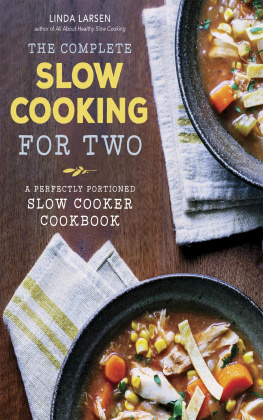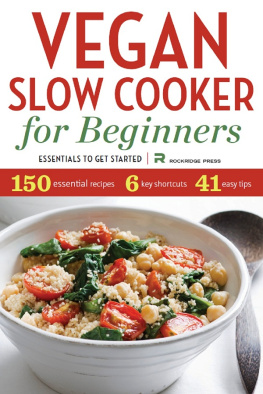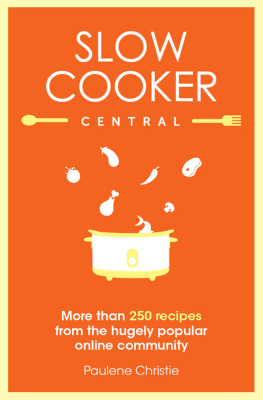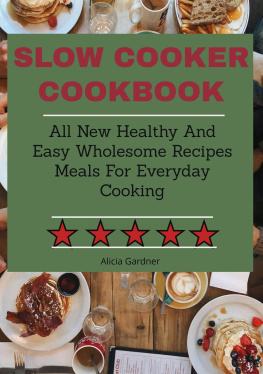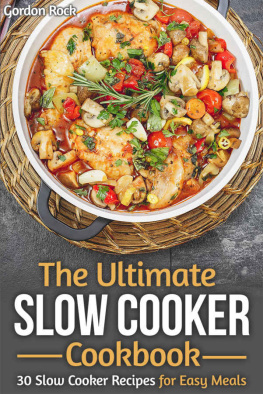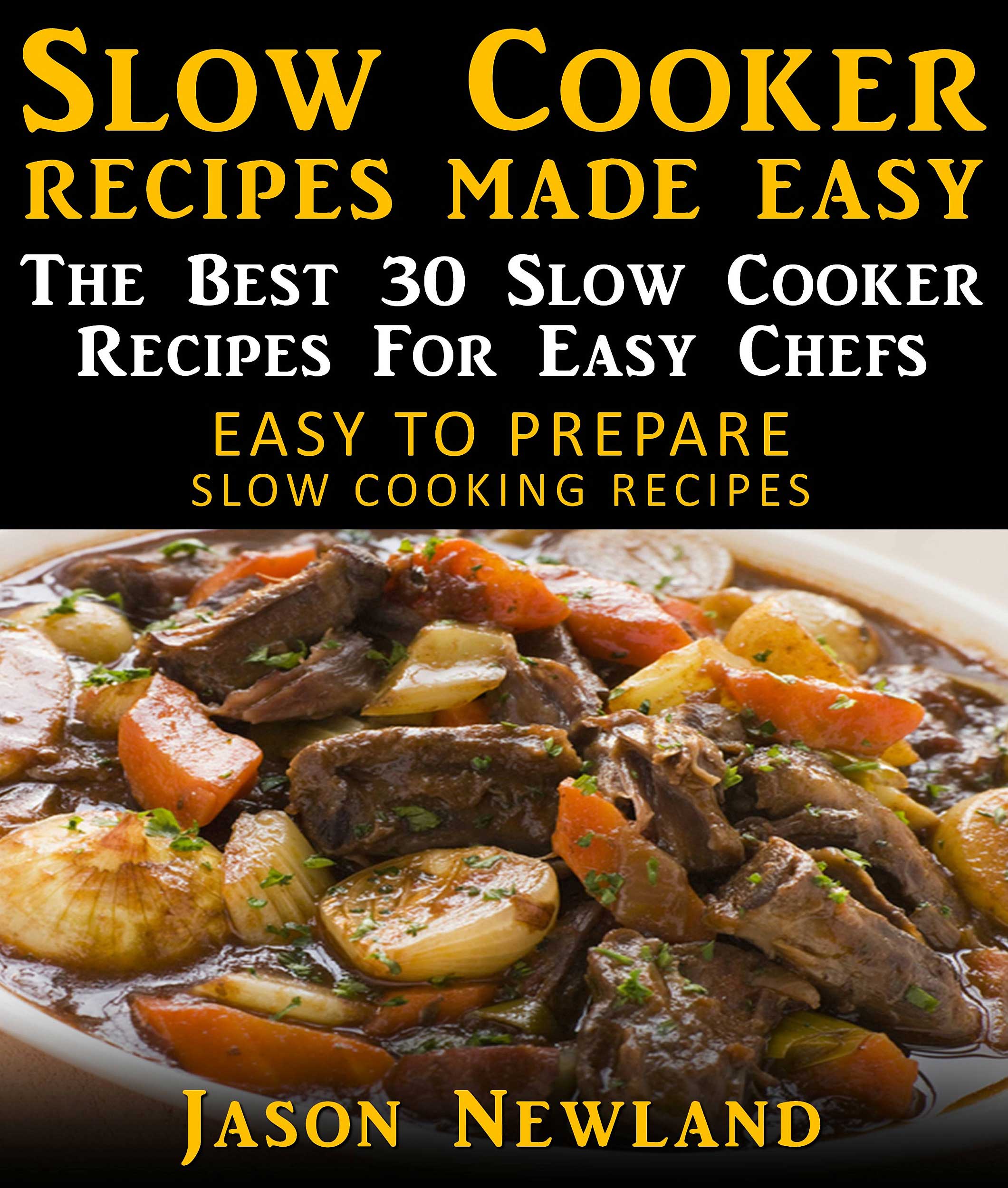Table of Contents
Slow Cooker Recipes Made Easy: The Best 30 Slow Cooker Recipes For Easy Chefs
Easy To Prepare Slow Cooking Recipes
By: Jason Newland
Chapter 1- What Is A Slow Cooker & Where Did It Come From?

A slow cooker is a counter top appliance for the kitchen that uses electrically heated coils or strips to simmer food stock at low temperatures. It resembles a large bowel or pot, usually made from ceramic or porcelain material and equipped with a glass lid. The more familiar term is Crock Pot, which is a trademark name. The slow cooker is idea for preparing large stews, scratch soups and pot roast dinners. They rely on boiling rather than baking, frying or roasting and this requires much higher cooking temperatures. Equipped with a timer and temperature control, slow cookers can be left unattended for several hours and longer.
Slow Cooker Origin
The Naxon Beanery All-Purpose Cooker was developed by the Naxon Utilities Company of Chicago Illinois in early 1970. It was originally intended as a slow bean cooker and had a simple round design. It came with a fixed crock interior liner and a glass lid. The Rival Company bought the rights to the cooker in 1970, renamed it the Crock Pot and released its version to the market in 1971. Rival introduced a updated version of the Crock Pot in 1974 that had a removable stoneware liner that could be extracted and easily cleaned. Rival experienced sales of over $30 million in the flowing 10 years of production and sales. Another design change came with the shape of the pot offered in an oval configuration in 1997. A programmable temperature controlled Crock Pot was introduced in 2001, with the name Smart Pot. In 2003 an expanded version called the Recipe Smart-Pot was introduced which contained over 200 pre-programmed recipes that took the guesswork out of temperature settings and cooking duration. After its arrival and popularity in the following years, the slow cooker, or Crock Pot brand, has been acquired by Sunbeam Products, with brand variations put out by other companies such as General Electric, West Bend Housewares and Hamilton Beach.
Design Features
The most common shapes of the slow cooker are the basic round design and the oval or elongated version. The oval design accommodated the longer roast sizes. The interior pot material is made of slick porcelain or highly glazed ceramic that is most often surrounded by a metal shell. The heating element is typically located in the bottom or lower sides of the pot, allowing the heat to transfer to the interior cooking chamber. The pot lid can be solid or visible glass in either a semi-flat or arched design. The lid has a surrounding groove that collects heated vapor, functioning as an atmospheric seal. The slow cooker does not build up pressure like a pressure cooker, but operates at normal outside pressure. Slow cookers come in very small capacities as in 16 ounces, on up to larger models that may contain as much as seven quarts.
Slow cookers have controls in either digital or dial designs which have three or four settings, usually designated as low, medium and high, with some models equipped with a keep warm option. Temperature variations range from 170 degrees Fahrenheit to 200 degrees Fahrenheit in the low and high ranges receptively. The design nature of the slow cooker is two-fold; it serves as a container for food stock as well as provides a heat sink that keeps a steady and constant temperature. Since very little heat and vapor is expended to the atmosphere, the slow cooker saves energy by conserving its heat.
Cooking Operation
Slow cookers excel when a combination of raw foods are used in the contents. Such foods would include onions, carrots, tomatoes, potatoes, beans, meats, fish or poultry. The ingredients can be diced or left whole. The heating liquid can be water, a vegetable or meat stock or even a wine base. The height of the liquid is proportionate to the amount of ingredients, but works best when the ingredients are covered completely. Once the pot is filled, the cooker is switched on to the high setting of approximately 200 degrees Fahrenheit, which allows a maximum cooking period. Some slow cooker models have an automatic step-down feature that reduces the heat to a lower setting once the initial cooking has been completed, while other models might need a manual adjustment after a certain time period. During the cooking and heating process the ingredients form a natural blend that distributes the overall flavor. The end result is a thick porridge or stew, boiled to a soft and tender consistency. Slow cookers retain their heat so well after being turned off that the food can be transported and served warn at a different location. The nature of the pot design on some models is spill-proof, allowing safe transportation in a vehicle or from indoor to outdoors.
The most sophisticated slow cooker models are programmable, which might include a start-cooking time delay for a person who might be absent but need to start the process automatically. Other models have programmable temperature sensors that begin the high cooking cycle and then stage down gradual through the lower settings.
The Benefits of Slow Cookers
Slow cookers show the best results when lesser grade meats are used. Meats with little muscle fiber and tough connective tissue break down more readily under prolonged boiling. Large bones and shanks that might have been thrown away are ideal for slow cooking, since the meat readily separates and contributes to the flavor.
Even on the highest setting, slow cooking rarely, if ever, burns food to the point of waste. The liquid or stock level is easily observed and maintained, even though very little evaporation is involved.
Including multiple vegetables and meats to the menu make the slow cooked meal the one and only course which negates the use of extra pans and pots to prepare other side dishes. Slow cooked meals can feed large families or small groups at one setting without the need of cooking extra portions. They also provide leftovers when left on the warm setting.
Chapter 2- Is Cooking In A Slow Cooker Healthy?
With busy work schedules, it's not uncommon to find a family who regularly uses a slow cooker. Before leaving for work in the morning, mothers and fathers prepare the recipe; push a button and the meal cooks throughout the day. By the time everyone is home, the dinner is ready. Along with the popularity of slow cookers, however, has come an increasing interest in health. Is it healthy to cook meals in a slow cooker? Well, it really depends on certain factors.
Cooking the Meat
Taking a package of raw chicken, dumping it into the slow cooker and then leaving it on low for eight hours might not kill all of the germs. Chicken needs to reach a temperature of 165 degrees Fahrenheit to be considered safe for consumption. Therefore, you may want to cook the chicken or other meat, on the stove top a bit before putting it in the slow cooker. In addition to heating it up, this process helps to brown the meat and give it more of a crisp.
Where Does the Moisture Come From?
Leaving food cooking all day can certainly have the opportunity to make it dry. As a result of this concern, some people pour butter and oil all over the meats they put into the slow cooker. Generally, meats in the slow cooker wind up basting in their own juices, so it's not usually necessary to put in these extra liquids. Of course, butters and oils add plenty of fats to the food, and you don't want that in a healthy diet. If you must add more moisture t to the slow cooker, light butter and extra virgin olive oil are better alternatives. You can also add some low sodium and/or low fat chicken broth into the slow cooker.



